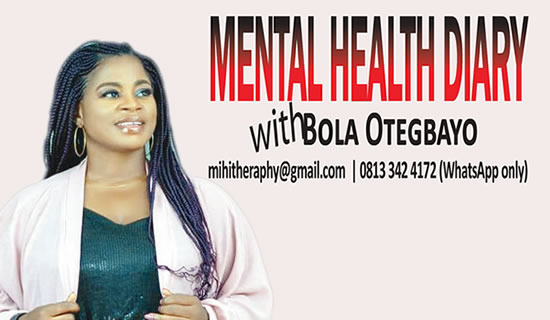A few days ago, I was engaged to provide therapy for a young lady who was ill and admitted to the hospital. She was unable to study for her upcoming final year exams at the university, which were just a few days away. Overwhelmed with anxiety, she was also stressed about her plans to travel overseas shortly after the exams, with her flight already booked. The pressure of these overlapping stressors not only affected her mentally but also hindered her recovery.
After speaking with her, the encounter stayed with me, and when I returned to my office, I scribbled in my Mental Health Diary: Anxiety. It was clear that her anxiety had become more than just a fleeting feeling, it had actually become a disorder impacting her recovery and well-being.
Anxiety is a common emotion that everyone experiences at some point. It often serves as a natural response to stress, helping us stay alert and prepare for challenging situations. Whether it’s the nerves before a big presentation or the restless nights spent thinking about an important decision, these fleeting feelings are a part of life. However, for some, anxiety goes beyond the occasional worry. It becomes a persistent, overwhelming force that disrupts daily life and impedes well-being. Understanding the line between everyday worries and anxiety disorders is crucial for knowing when to seek help and how to manage symptoms effectively.

Anxiety can be defined as a feeling of unease, such as worry or fear, that can be mild or severe. It acts as a natural alarm system, warning us of potential threats and preparing the body to respond. While this response is beneficial in moderation, it becomes problematic when it is excessive, irrational, or chronic. When anxiety becomes persistent and interferes with daily functioning, it may signal the presence of an anxiety disorder. Anxiety disorders are among the most common mental health issues worldwide and affect millions of people each year. These disorders differ from ordinary stress by their intensity, duration, and impact on a person’s life.
Differentiating between typical worries and an anxiety disorder can be challenging. Normal worries are usually temporary, related to a specific event or task, and do not interfere significantly with daily life. On the other hand, anxiety disorders are marked by their persistence. The worry is excessive and often out of proportion to the actual risk involved. For instance, someone might feel anxious before a job interview, but if the worry starts weeks before and impacts their sleep and ability to focus, it may be more than just a normal concern. Physical symptoms such as muscle tension, headaches, fatigue, and sleep disturbances are also common with anxiety disorders. When a person finds themselves avoiding certain activities or places due to fear, such as social gatherings or open spaces, it could indicate a social anxiety disorder or agoraphobia.
There are several types of anxiety disorders, each comes with unique features. Generalized Anxiety Disorder (GAD) involves chronic and exaggerated worry about various aspects of life, such as work, health, or family, accompanied by symptoms like restlessness and difficulty concentrating. Panic Disorder is characterized by sudden, unexpected panic attacks that include intense physical symptoms such as a racing heart, sweating, and shortness of breath. These attacks often come without warning and create a fear of future episodes. Social Anxiety Disorder, or social phobia, involves a persistent fear of social situations due to a fear of embarrassment or judgment. This fear can be so severe that it leads to avoidance of social interactions altogether. Specific phobias, like the fear of flying or heights, trigger intense fear related to a specific object or situation. Although these fears may seem irrational, they can provoke severe anxiety and avoidance behaviors. Separation Anxiety Disorder, though commonly associated with children, can affect adults as well and is marked by intense fear related to being apart from loved ones or familiar environments.
Overcoming anxiety involves a combination of self-help practices, lifestyle changes, and professional treatment. One of the most accessible methods is mindfulness and relaxation practices. Deep breathing exercises can calm the body’s stress response by activating the parasympathetic nervous system. Practicing progressive muscle relaxation, where each muscle group is tensed and then relaxed, helps to release physical tension and promotes a sense of calm. Guided meditation and visualization techniques, where a person imagines a peaceful scene or recalls a positive memory, can also shift focus away from anxious thoughts and promote relaxation.

Lifestyle changes can play a significant role in managing anxiety. Regular physical activity, such as walking, yoga, or strength training, helps release endorphins that improve mood and reduce stress hormones. Maintaining a balanced diet that includes omega-3 fatty acids and magnesium supports brain health and can lower anxiety levels. Sleep is another crucial factor; practicing good sleep hygiene, like establishing a consistent sleep schedule and reducing screen time before bed, can improve sleep quality and reduce anxiety symptoms.
Cognitive restructuring is a valuable self-help tool where a person learns to identify and challenge irrational or negative thoughts. Writing down anxious thoughts and countering them with more realistic statements can change the way one perceives a situation. For instance, if someone is worried about failing an exam, they can replace the thought, “I will fail and never succeed,” with “I have studied and will do my best, which is enough.”
Grounding techniques are effective in redirecting focus when anxiety becomes overwhelming. One method is the “5-4-3-2-1” exercise, where a person lists five things they can see, four things they can feel, three things they can hear, two things they can smell, and one thing they can taste. This practice helps to anchor the mind in the present moment, reducing the intensity of anxious thoughts.
In some cases, self-help strategies may not be enough, and professional intervention is needed. Cognitive-Behavioral Therapy (CBT) is one of the most effective treatments for anxiety disorders. It helps individuals identify and modify negative thought patterns and develop coping skills. Therapists play a crucial role in guiding clients through this process by teaching them how to reframe negative thinking, challenge irrational beliefs, and use evidence-based techniques to build resilience. They provide a safe space where individuals can explore their fears and learn practical ways to handle anxiety-provoking situations.
Medications may also be recommended for severe anxiety under a doctor’s prescription and supervision. These medications work by balancing serotonin levels in the brain and can be effective in managing anxiety when combined with therapy.
Despite the challenges, it is possible to overcome anxiety with patience and persistence. Progress may be gradual, and setbacks are normal, but small, consistent steps can make a significant impact. Celebrating minor victories, whether it’s managing a social situation without excessive worry or completing a task without fear, is important in the journey to recovery. Anxiety is not a sign of weakness, and seeking help demonstrates courage and a commitment to well-being.
Anxiety disorders are treatable, and there is hope for those who experience them. If you or someone you know struggles with anxiety, consulting a mental health professional is an essential first step toward recovery. Effective treatment plans often combine self-help practices, lifestyle adjustments, and professional guidance. Remember, anxiety is a condition that can be managed, and with the right strategies and support, individuals can regain control and lead fulfilling lives. When anxiety becomes persistent and interferes with daily functioning, it may signal the presence of an anxiety disorder. Anxiety disorders are among the most common mental health issues worldwide and affect millions of people each year. These disorders differ from ordinary stress by their intensity, duration, and impact on a person’s life.
Differentiating between typical worries and an anxiety disorder can be challenging. Normal worries are usually temporary, related to a specific event or task, and do not interfere significantly with daily life. On the other hand, anxiety disorders are marked by their persistence. The worry is excessive and often out of proportion to the actual risk involved. For instance, someone might feel anxious before a job interview, but if the worry starts weeks before and impacts their sleep and ability to focus, it may be more than just a normal concern. Physical symptoms such as muscle tension, headaches, fatigue, and sleep disturbances are also common with anxiety disorders. When a person finds themselves avoiding certain activities or places due to fear, such as social gatherings or open spaces, it could indicate a social anxiety disorder or agoraphobia.
There are several types of anxiety disorders, each comes with unique features. Generalized Anxiety Disorder (GAD) involves chronic and exaggerated worry about various aspects of life, such as work, health, or family, accompanied by symptoms like restlessness and difficulty concentrating. Panic Disorder is characterized by sudden, unexpected panic attacks that include intense physical symptoms such as a racing heart, sweating, and shortness of breath. These attacks often come without warning and create a fear of future episodes. Social Anxiety Disorder, or social phobia, involves a persistent fear of social situations due to a fear of embarrassment or judgment. This fear can be so severe that it leads to avoidance of social interactions altogether. Specific phobias, like the fear of flying or heights, trigger intense fear related to a specific object or situation. Although these fears may seem irrational, they can provoke severe anxiety and avoidance behaviors. Separation Anxiety Disorder, though commonly associated with children, can affect adults as well and is marked by intense fear related to being apart from loved ones or familiar environments.
Overcoming anxiety involves a combination of self-help practices, lifestyle changes, and professional treatment. One of the most accessible methods is mindfulness and relaxation practices. Deep breathing exercises can calm the body’s stress response by activating the parasympathetic nervous system. Practicing progressive muscle relaxation, where each muscle group is tensed and then relaxed, helps to release physical tension and promotes a sense of calm. Guided meditation and visualization techniques, where a person imagines a peaceful scene or recalls a positive memory, can also shift focus away from anxious thoughts and promote relaxation.
Lifestyle changes can play a significant role in managing anxiety. Regular physical activity, such as walking, yoga, or strength training, helps release endorphins that improve mood and reduce stress hormones. Maintaining a balanced diet that includes omega-3 fatty acids and magnesium supports brain health and can lower anxiety levels. Sleep is another crucial factor; practicing good sleep hygiene, like establishing a consistent sleep schedule and reducing screen time before bed, can improve sleep quality and reduce anxiety symptoms.
Cognitive restructuring is a valuable self-help tool where a person learns to identify and challenge irrational or negative thoughts. Writing down anxious thoughts and countering them with more realistic statements can change the way one perceives a situation. For instance, if someone is worried about failing an exam, they can replace the thought, “I will fail and never succeed,” with “I have studied and will do my best, which is enough.”
Grounding techniques are effective in redirecting focus when anxiety becomes overwhelming. One method is the “5-4-3-2-1” exercise, where a person lists five things they can see, four things they can feel, three things they can hear, two things they can smell, and one thing they can taste. This practice helps to anchor the mind in the present moment, reducing the intensity of anxious thoughts.
In some cases, self-help strategies may not be enough, and professional intervention is needed. Cognitive-Behavioral Therapy (CBT) is one of the most effective treatments for anxiety disorders. It helps
individuals identify and modify negative thought patterns and develop coping skills. Therapists play a crucial role in guiding clients through this process by teaching them how to reframe negative thinking, challenge irrational beliefs, and use evidence-based techniques to build resilience. They provide a safe space where individuals can explore their fears and learn practical ways to handle anxiety-provoking situations.
Medications may also be recommended for severe anxiety under a doctor’s prescription and supervision. These medications work by balancing serotonin levels in the brain and can be effective in managing anxiety when combined with therapy.
Despite the challenges, it is possible to overcome anxiety with patience and persistence. Progress may be gradual, and setbacks are normal, but small, consistent steps can make a significant impact. Celebrating minor victories, whether it’s managing a social situation without excessive worry or completing a task without fear, is important in the journey to recovery. Anxiety is not a sign of weakness, and seeking help demonstrates courage and a commitment to well-being.
Anxiety disorders are treatable, and there is hope for those who experience them. If you or someone you know struggles with anxiety, consulting a mental health professional is an essential first step toward recovery. Effective treatment plans often combine self-help practices, lifestyle adjustments, and professional guidance. Remember, anxiety is a condition that can be managed, and with the right strategies and support, individuals can regain control and lead fulfilling lives.
READ ALSO: Massive turnout as Ayedatiwa/Adelami campaign hits Ondo West







